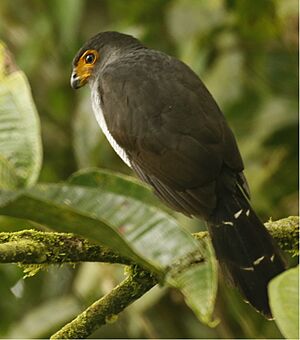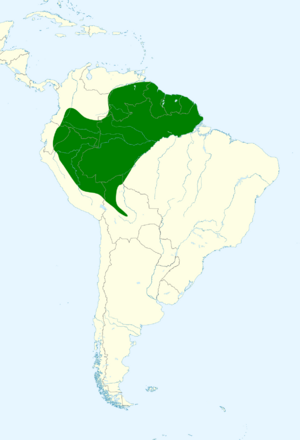Lined forest falcon facts for kids
Quick facts for kids Lined forest falcon |
|
|---|---|
 |
|
| Conservation status | |
| Scientific classification | |
| Genus: |
Micrastur
|
| Species: |
gilvicollis
|
 |
|
The lined forest falcon (Micrastur gilvicollis) is a type of bird of prey that lives in the forests of South America. It belongs to the falcon family, which includes other fast and powerful birds like falcons and caracaras. You can find this bird in countries like Bolivia, Brazil, Colombia, Ecuador, French Guiana, Guyana, Peru, Suriname, and Venezuela.
Contents
About the Lined Forest Falcon
How Scientists Classify This Bird
For a long time, the lined forest falcon was thought to be just a type of barred forest falcon. But in 1972, scientists started to think it was its own unique species. This idea was finally confirmed in 2019 after more studies.
Another bird, the cryptic forest falcon, was once considered part of the lined forest falcon family. However, in 2002, studies of their calls and physical features showed that it was a completely different species. Sometimes, the plumbeous forest falcon has also been confused with the lined forest falcon.
The lined forest falcon is a "monotypic" species. This means it doesn't have any different subspecies or types within its own group.
What Does It Look Like?
The lined forest falcon is about 33 to 38 centimeters (13 to 15 inches) long. It weighs between 170 and 262 grams (6 to 9 ounces). Its back and upper parts are a light gray color. Its belly and underside are white, but they have gray stripes or bars. These stripes can be light and only on its chest, or they can be heavy and cover its whole underside.
Its tail is dark gray with a white tip and two thin white stripes. The bird has white eyes, surrounded by bare, reddish-orange skin. Its legs and feet are yellow.
Where It Lives and Its Home
Distribution and Habitat
The lined forest falcon lives in the Amazon Basin, a huge forest area in South America. You can find it from eastern Colombia, Ecuador, and Peru, all the way to northern Bolivia. It also lives east through Venezuela, a region called the Guianas, and northern Brazil, reaching the Atlantic coast.
This bird mostly lives deep inside healthy, untouched tropical primary forest. It can also be found in smaller numbers in secondary forest (forests that have grown back) and at the edges of forests. In Colombia and Ecuador, it prefers a type of forest called terra firme forest, which means "dry land" forest, not flooded areas. It can live from sea level up to about 1,600 meters (5,200 feet) high in the mountains.
Behavior and Lifestyle
Movement and Migration
As far as we know, the lined forest falcon stays in the same area all year round. It doesn't migrate or move to different places during certain seasons.
What It Eats and How It Hunts
The lined forest falcon usually hunts in the lower parts of the forest, close to the ground. Scientists haven't fully described its diet, but we know it eats a variety of animals. These include lizards, large insects, other birds, snakes, and small mammals. Sometimes, it even follows army ant swarms, catching the small creatures that try to escape the ants.
Reproduction and Life Cycle
Scientists don't know much about how the lined forest falcon breeds or raises its young. It's likely that its breeding habits are similar to those of the barred forest falcon.
How It Communicates (Vocalization)
The most common sound the lined forest falcon makes is a series of "nasal" calls. These calls can sound like "cow-káh," "cow káw-káw," or "cow káw-káw-káw." It usually calls before the sun comes up in the morning and when the weather is wet.
Conservation Status
Is It Endangered?
The IUCN (International Union for Conservation of Nature) has assessed the lined forest falcon as a species of "Least Concern." This means it's not currently considered endangered or at high risk of extinction.
Even though it has a very large area where it lives, scientists don't know exactly how many lined forest falcons there are. They believe the population might be slowly decreasing. However, no immediate big threats have been found for this bird. In many parts of the Amazonian lowland forest, it's thought to be "the most abundant" bird of prey that hunts during the day, meaning there are lots of them in those areas.


